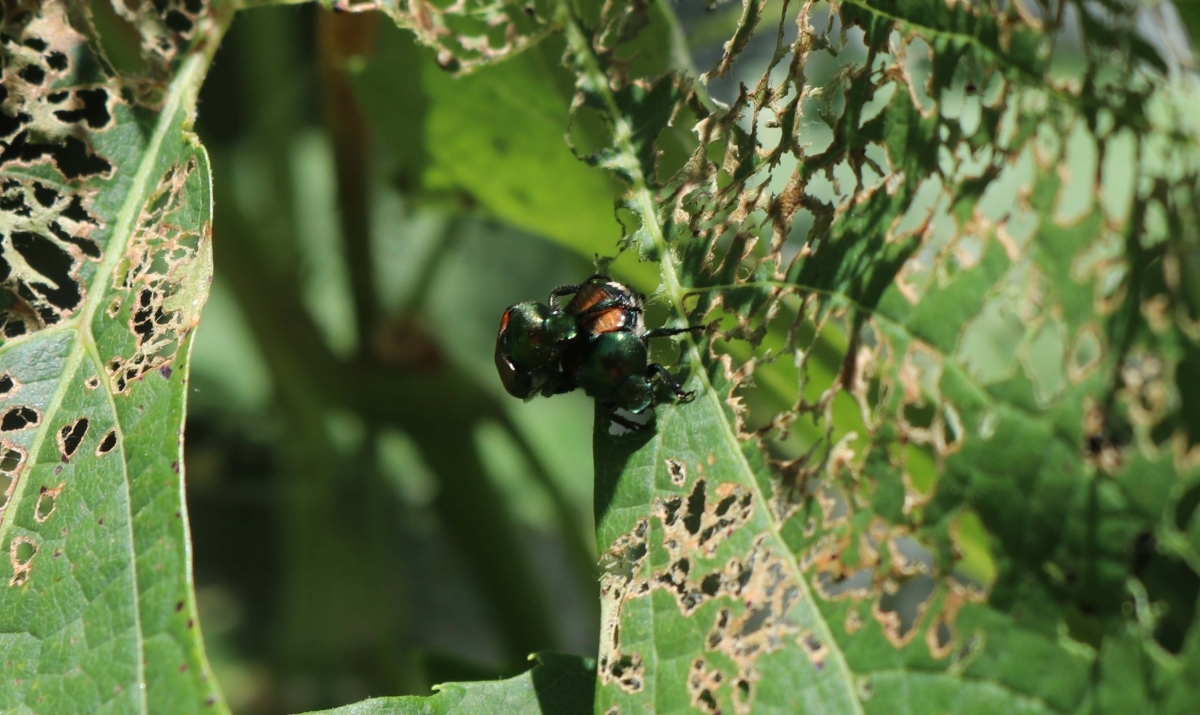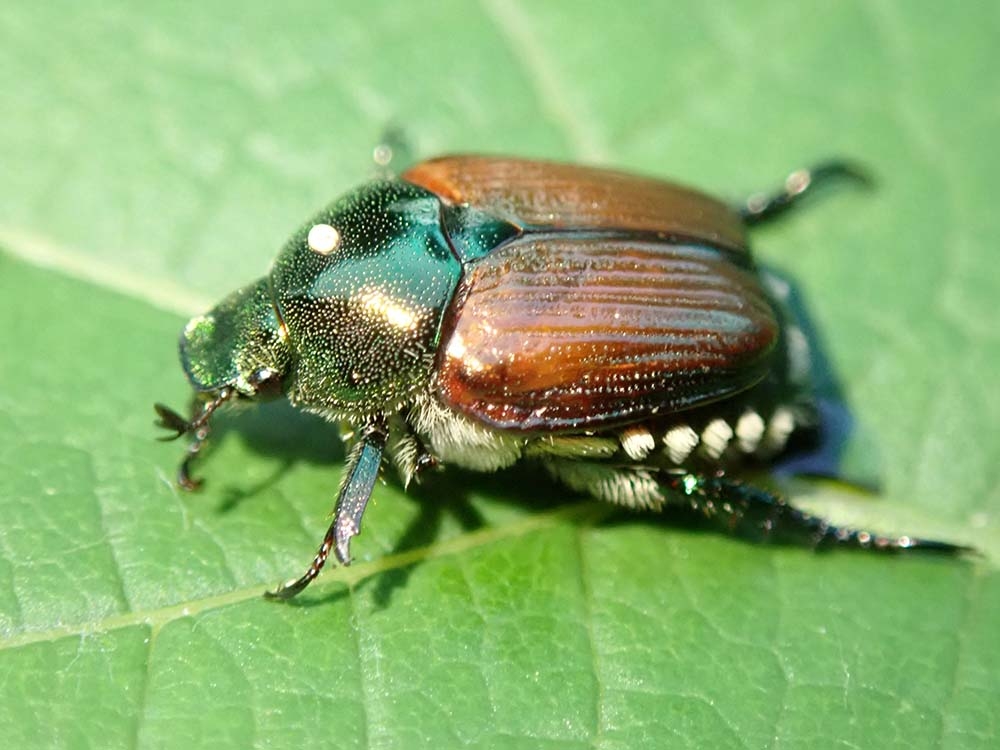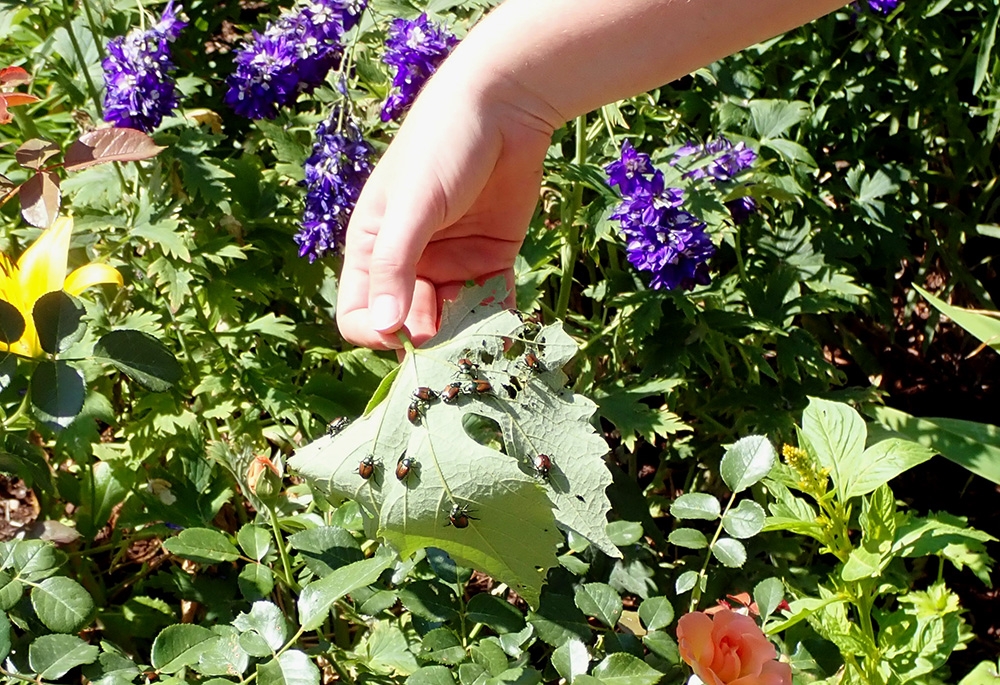Japanese Beetle Biological Control Release
Japanese beetles (Popillia japonica) have become numerous around Denver Botanic Gardens – I can’t walk near grapes, roses or other flowering plants and not see them. Even though these insects are beautiful like glimmering green and copper jewels, the damage they cause is not.
Unfortunately, it’s challenging to use insecticides to manage this insect because these insects feed on flowers near pollinators. Spraying insecticides may have more impact on the pollinators and other beneficial insects than the beetles. The most effective method is to collect the insects off the plants and either crush them or drop them in soapy water.
In northern Japan where the Japanese beetle is native, they have a number of natural enemies that keep the populations in check. When the beetles were first detected in the United States in 1916, they had no natural enemies and were able to grow unchecked.
Starting in the 1920s, researchers began studying the Japanese beetle’s natural enemies, looking for species that could be introduced to help control the U.S. population as biological control. The natural enemies they selected are specific to the Japanese beetle, and do not move off target – they only seek out Japanese beetles.
On Friday, July 13, 2018, in conjunction with Dr. Whitney Cranshaw of Colorado State University Extension and the Colorado Department of Agriculture, I helped release over 100 infested beetles that had been parasitized by the winsome fly (Istocheta aldrichi). This fly lays eggs on the beetles, and once they hatch, the larvae crawls inside the beetle. The beetle buries itself shortly thereafter, and the larvae completes its life cycle inside the beetle carcass. In the late spring or early summer, the fly emerges, ready to begin the cycle anew.
The hope with releasing this insect is that the fly will develop a population over subsequent years in order to assist in controlling the Japanese beetle. Eradication where the beetles are already well established (like Denver) is very challenging and highly unlikely. But, this is one tool in our toolbox that we are using to help control this nuisance pest.
This is not a random, sporadic release of insects to "see what happens.” Instead, it is a highly regulated, specific release with decades of research to back it up. There are a few sites that have been identified in the area that are part of this study. Hopefully over the next few years, we start seeing a decline in the sheer volume of Japanese beetles feeding on our beloved plants.
If you have other questions about the Japanese beetle, the biological control of it, or what you can do as a homeowner with this same problem, check out Dr. Cranshaw’s Questions and Answers about the Japanese Beetle.
Gallery



Comments
recommended home remedy?
Aside from picking off and putting in soapy water, are there other recommended home methods for control? I've read the traps are not a good idea because they will ultimately attract more beetles than you had to begin with (you will catch a few, but still attract more and therefore incur more damage). Any recommendations are appreciated. Our hibiscus tree is hurting!
At this point, the best
At this point, the best method is still just the tried-and-true pluck and drop in soapy water. Insecticides are available, but since the beetles prefer to feed on the flowers, using insecticides may cause more damage to pollinators than the beetles themselves. It is true that traps will invite more into your garden than it will remove, making it the least effective method for control.
plant health and fertilization
Doctor of Plant Health! What a fun doctorate. One question I've never been able to get answered about the Denver Botanic Gardens is if or when you fertilize. From a Plant Health perspective, is fertilization in decent soil necessary? What about micronutrients? Or even compost? Some of the DBG plants grow bigger and lusher. (like the Eremerus most years) than when I grow the same plants from the same sources in other gardens. I'm sure you water more, but what kind of fertilizing does a Botanic Garden do to make everything look spectacular. I already figured out years ago that well-placed water features help your plants a lot.
Each of the horticulturalists
Each of the horticulturalists individually decides what fertilization, if any, is necessary for their respective gardens, so I can't speak to a specific fertilization program for the Gardens as a whole. A lot of it has to do with the microclimates the Gardens provide - some areas are slightly better suited to a specific plant. The horticulturalists do water quite frequently to maintain the lush growth and diverse plant communities, but watering is also done on a garden-by-garden basis.
Unless your plants are showing signs of nutrient deficiencies, there really is no need to fertilize above and beyond what is already in the soil. The addition of extra nutrients the plants cannot take up can result in a negative effect in high enough concentrations, depending on the soil and nutrient concentrations. If you're concerned about your nutrient levels, Colorado State University does have a soil test lab where you can send samples and get recommendations based on your specific soils. Otherwise, unless the plants indicate they are missing something (stunted growth, discoloration, etc.), there is no need for excess fertilizer.
Marvel of peru kills beetles?
Hello, I heard that the Marvel of Peru 4 O'clock flowers attract, then kill Japanese Beetles. Is this true?
4 O’clock flowers and Japanese beetles
Hi Rachael,
I checked with Mario Bertelmann, one of our horticulturists, and here is what he shared:
"I have done some digging on this question and it does not appear that this claim has been proven. There are mixed reports as to whether 4 O’clock flowers attract/kill Japanese beetles. However, studies on zonal geraniums have shown more promising results as the flowers contain a rare excitatory amino acid that temporarily paralyzes the beetles, leaving them susceptible to predators. Below is a link to the USDA site where it discusses the use of geraniums to combat Japanese beetles as well as a link to a scientific peer reviewed study on the effects of geraniums on Japanese beetles."
https://www.ars.usda.gov/news-events/news/research-news/2010/geraniums-could-help-control-devastating-japanese-beetle/
https://www.ncbi.nlm.nih.gov/pmc/articles/PMC3029778/
Thanks for the question!
Doris Boardman
Website & SEO Manager
Add new comment